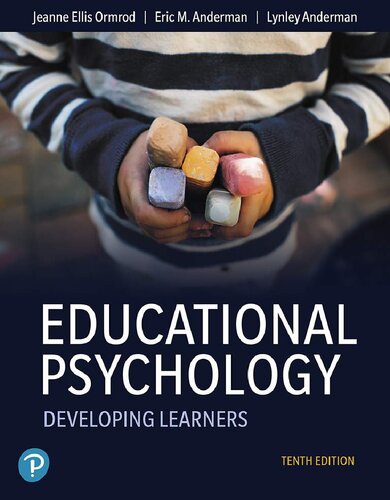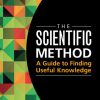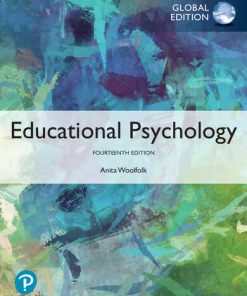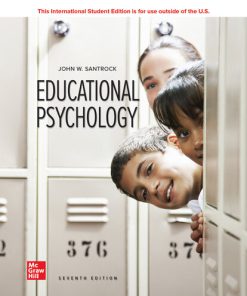Educational Psychology: Developing Learners (10th Edition) by Jeanne Ellis Ormrod 9780135208212 0135208211
$50.00 Original price was: $50.00.$25.00Current price is: $25.00.
Educational Psychology: Developing Learners (10th Edition) Jeanne Ellis Ormrod – Ebook Instant Download/Delivery ISBN(s): 9780135206478,0135206472,9780135208212, 0135208211

Product details:
- ISBN 10:0135208211
- ISBN 13:9780135208212
- Author: Jeanne Ellis Ormrod
Educational Psychology: Developing Learners
Table contents:
Chapter 1 Teaching and Educational Psychology
Learning Outcomes
Reflecting on What You Already Know About Learning and Instruction
Studying and Learning Effectively
Developing as a Teacher
Understanding and Interpreting Research Findings
Quantitative Research
Descriptive Studies
Correlational Studies
Experimental and Quasi-Experimental Studies
Qualitative Research
Mixed-Methods Research
Interpreting Research Results: A Cautionary Note
From Research to Practice: The Importance of Principles and Theories
Collecting Data and Drawing Conclusions About Your Own Students
Assessing Students’ Achievements and Interpreting Their Classroom Behaviors
Conducting Action Research
Chapter 1 What Have You Learned?
Practice for Your Licensure Exam New Software
Part 1 Development and Diversity
Chapter 2 Cognitive and Linguistic Development
Learning Outcomes
General Principles of Human Development
The Multiple Layers of Environmental Influence: Bioecological Systems and the Importance of Culture
Role of the Brain in Learning and Development
Piaget’s Theory of Cognitive Development
Piaget’s Basic Assumptions
Piaget’s Proposed Stages of Cognitive Development
Preoperational Stage (Age 2 Through Age 6 Or 7)
Concrete Operations Stage (Age 6 Or 7 Through Age 11 or 12)
Formal Operations Stage (Age 11 or 12 through Adulthood)
Critiquing Piaget’s Theory
A Second Look at Piaget’s Stages
Considering Diversity from the Perspective of Piaget’s Theory
Contemporary Extensions and Applications of Piaget’s Theory
Neo-Piagetian Theories
Piaget’s Clinical Method as an Assessment Tool
Hands-on Experiences
Creating Disequilibrium: The Value of Sociocognitive Conflict
Vygotsky’s Theory of Cognitive Development
Vygotsky’s Basic Assumptions
Critiquing Vygotsky’s Theory
Considering Diversity from the Perspective of Vygotsky’s Theory
Contemporary Extensions and Applications of Vygotsky’s Theory
Social Construction of Meaning
Scaffolding
Guided Participation in Challenging New Activities
Apprenticeships
Contrasting Piaget’s and Vygotsky’s Theories
Language Development
Theoretical Issues Regarding Language Development
Diversity in Language Development
Second-Language Learning and English Language Learners
Bilingualism
Teaching a Second Language
Chapter 2 What Have You Learned?
Practice for Your Licensure Exam A Floating Stone
Chapter 3 Personal and Social Development
Learning Outcomes
Personality Development
Temperament
Environmental Influences on Personality Development
Family Dynamics
Child Maltreatment
Cultural Expectations and Socialization
The “Big Five” Personality Traits
Temperament, Personality, and Goodness of Fit
Development of a Sense of Self
Factors Influencing Sense of Self
Developmental Changes in Sense of Self
Childhood
Early Adolescence
Late Adolescence
Diversity in Sense of Self
Gender Differences
Cultural and Ethnic Differences
Development of Peer Relationships and Interpersonal Understandings
Roles of Peers in Children’s Development
Common Social Groups in Childhood and Adolescence
Friendships
Cliques, Crowds, and Subcultures
Gangs
Romantic Relationships
Popularity and Social Isolation
Social Cognition
Perspective Taking
Childhood.
Early adolescence.
Late adolescence.
Promoting perspective taking.
Social Information Processing
Aggression
Technology and Peer Relationships
Diversity in Peer Relationships and Social Cognition
Gender Differences
Cultural and Ethnic Differences
Promoting Healthy Peer Relationships
Moral and Prosocial Development
Developmental Trends in Morality and Prosocial Behavior
Factors Influencing Moral and Prosocial Development
Diversity in Moral and Prosocial Development
Gender Differences
Cultural and Ethnic Differences
Encouraging Moral and Prosocial Development at School
Chapter 3 What Have You Learned?
Practice for Your Licensure Exam The Scarlet Letter
Chapter 4 Group Differences
Learning Outcomes
Cultural and Ethnic Differences
Navigating Different Cultures at Home and at School
Cultural Competence
Language and Dialect
Talkativeness and Verbal Assertiveness
Eye Contact
Personal Space
Responding to Questions
Public Versus Private Performance
Views about Teasing
Cooperation Versus Competition
Family Relationships and Expectations
Conceptions of Time
Worldviews
Creating a Culturally Inclusive Classroom Environment
Gender Differences
Research Findings Regarding Gender Differences
Physical Activity And Motor Skills
Cognitive and Academic Abilities
Experience with Technology
Motivation in Academic Activities
Sense of Self
Interpersonal Behaviors and Relationships
Classroom Behaviors
Career Aspirations
Origins of Gender Differences
Making Appropriate Accommodations for Gender Differences
Socioeconomic Differences
Challenges Associated with Poverty
Poor Nutrition and Health.
Inadequate Housing and Frequent Moves.
Exposure to Toxic Substances.
Unhealthy Social Environments.
Emotional Stress.
Gaps in Background Knowledge.
Lower-quality Schools.
Fostering Resilience
Working with Homeless Students
Students at Risk
Characteristics of Students at Risk
Why Students Drop Out
Supporting Students at Risk
Chapter 4 What Have You Learned?
Practice for Your Licensure Exam The Active and the Passive
Chapter 5 Individual Differences and Special Educational Needs
Learning Outcomes
Intelligence
Theoretical Perspectives of Intelligence
Spearman’s Concept of g
Cattell’s Fluid and Crystallized Intelligences
Cattell–Horn–Carroll Theory of Cognitive Abilities
Gardner’s Multiple Intelligences
Sternberg’s Theory of Successful Intelligence
Developmental Views of Intelligence
Distributed Intelligence
Measuring Intelligence
IQ Scores and School Achievement
Nature and Nurture in the Development of Intelligence
Intelligence and the Brain
Cultural and Ethnic Diversity in Intelligence
Being Smart About Intelligence and IQ Scores
Cognitive Styles and Dispositions
There’s No Such Thing as Learning Styles
Does It Make Sense to Teach to Students’ “Right Brains” or “Left Brains”?
Analytic and Holistic Thinking
Dispositions
Educating Students with Special Needs in General Education Classrooms
Public Law 94-142: Individuals with Disabilities Education Act (IDEA)
Potential Benefits and Drawbacks of Inclusion
Identifying Students’ Special Needs
Students with Specific Cognitive or Academic Difficulties
Learning Disabilities
Common Characteristics
Adapting Instruction
Attention-Deficit Hyperactivity Disorder (ADHD)
Common Characteristics
Medication and ADHD
Adapting Instruction
Speech and Communication Disorders
Common Characteristics
Adapting Instruction
General Recommendations
Students with Social or Behavioral Problems
Emotional and Behavioral Disorders
Common Characteristics
Adapting Instruction
Autism Spectrum Disorders
Common Characteristics
Adapting Instruction
General Recommendations
Students with General Delays in Cognitive and Social Functioning
Intellectual Disabilities
Common Characteristics
Adapting Instruction
Students with Physical or Sensory Challenges
Physical and Health Impairments
Common Characteristics
Adapting Instruction
Visual Impairments
Common Characteristics
Adapting Instruction
Hearing Loss
Common Characteristics
Adapting Instruction
General Recommendations
Students with Advanced Cognitive Development
Giftedness
Common Characteristics
Adapting Instruction
Considering Diversity When Identifying and Addressing Special Needs
General Recommendations for Working with Students Who Have Special Needs
Chapter 5 What Have You Learned?
Practice for Your Licensure Exam Quiet Amy
Part 2 Learning and Motivation
Chapter 6 Learning, Cognition, and Memory
Learning Outcomes
Basic Assumptions of Cognitive Psychology
A Model of Human Memory
The Nature of the Sensory Register
Moving Information to Working Memory: The Role of Attention
The Nature of Working (Short-Term) Memory
Moving Information to Long-Term Memory: Connecting New Information with Prior Knowledge
The Nature of Long-Term Memory
Learning, Memory, and the Brain
Critiquing the Three-Component Model
Long-Term Memory Storage
How Knowledge Can Be Organized
How Declarative Knowledge Is Learned
Rote Learning
Meaningful Learning
Elaboration.
Internal organization.
Visual imagery.
Developmental Trends in Storage Processes for Declarative Information
How Procedural Knowledge Is Learned
Roles of Prior Knowledge and Working Memory in Long-Term Memory Storage
Encouraging a Meaningful Learning Set and Conceptual Understanding
Using Technology to Facilitate Meaningful Learning
Using Mnemonics in the Absence of Relevant Prior Knowledge
When Knowledge Construction Goes Awry: Addressing Learners’ Misconceptions
Obstacles to Conceptual Change
Promoting Conceptual Change
Long-Term Memory Retrieval
Factors Affecting Retrieval
Multiple Connections with Existing Knowledge and a Variety of Contexts
Distinctiveness
Emotional Overtones
Regular Practice and Review
Relevant Retrieval Cues
Wait Time
Why Learners Sometimes Forget
Failure to Store or Consolidate Information in Long-Term Memory
Decay
Unsuccessful Search of Long-Term Memory
Interference
Reconstruction Error
Diversity in Cognitive Processes
Facilitating Cognitive Processing in Students with Special Needs
Chapter 6 What Have You Learned?
Practice for Your Licensure Exam Vision Unit
Chapter 7 Complex Cognitive Processes
Learning Outcomes
Thinking About Thinking and Learning How to Learn: The Importance of Metacognition
Effective Learning Strategies
Overt Strategies
Taking notes.
Creating summaries.
Covert Strategies
Identifying important information.
Regularly monitoring learning.
Factors Affecting Strategy Use
Metacognitive Strategies in the Digital Age
Diversity, Disabilities, and Exceptional Abilities in Metacognition
Accommodating Students with Special Needs
Transfer
Factors Affecting Transfer
Problem Solving and Creativity
Factors Affecting Problem-Solving Success and Creative Thinking
Teaching Problem-Solving Strategies
Fostering Creative Thinking
Using Computer Technology to Foster and Support Creative Problem-Solving
Critical Thinking
Encouraging Critical Thinking in the Classroom, the Outside World, and Cyberspace
Diversity in Transfer, Problem Solving, Creativity, and Critical Thinking
Accommodating Students with Special Needs
Chapter 7 What Have You Learned?
Practice for Your Licensure Exam Interview with Charlie
Chapter 8 Learning and Cognition in Context
Learning Outcomes
Basic Assumptions of Contextual Theories
Social Interactions as Contexts
Interactions with More Advanced Individuals
Interactions with Peers
Creating a Community of Learners
Cultures as Contexts
Schemas, Scripts, and Worldviews as Aspects of Culture
Communities of Practice as Aspects of Culture
Societies as Contexts
Authentic Activities
Digital Technologies as Contexts
Technology in Learning and Instruction
General Guidelines for Using Technology Effectively in Instruction
Promoting Technological Literacy
Online Learning
Academic Content Domains as Contexts
Language Arts: Reading and Writing
The Nature of Skilled Reading
The Nature of Skilled Writing
Promoting Reading and Writing Development
Mathematics
Promoting Learning in Mathematics
Science
Promoting Learning in Science
Social Studies
The Nature of Historical Knowledge and Thinking
The Nature of Geographic Knowledge and Thinking
Promoting Learning in Social Studies
Taking Student Diversity into Account
Accommodating Students with Special Needs
Chapter 8 What Have You Learned?
Practice for Your Licensure Exam The Birth of a Nation
Chapter 9 Behaviorist Views of Learning
Learning Outcomes
Basic Assumptions of Behaviorism
Building on Existing Stimulus–Response Associations: Classical Conditioning
Classical Conditioning of Involuntary Emotional Responses
Common Phenomena in Classical Conditioning
Generalization
Extinction
Addressing Counterproductive Emotional Responses
Learning from Consequences: Instrumental Conditioning
Contrasting Classical Conditioning and Instrumental Conditioning
The Various Forms That Reinforcement Can Take
Primary versus Secondary Reinforcers
Positive versus Negative Reinforcement
Positive reinforcement.
Negative reinforcement.
Looking at Reinforcement from a Developmental Perspective
The Various Forms That Punishment Can Take
Consequences That Serve as Effective Punishment
Forms of Punishment That May Undermine Desired Behavior Changes
Consequences with Mixed Reviews
Strategies for Encouraging Productive Behaviors and Discouraging Undesirable Ones
Using Reinforcement Effectively
Shaping New Behaviors
Encouraging Desired Behaviors Through Antecedent Stimuli and Responses
Cueing
Setting Events
Generalization
Discrimination
Behavioral Momentum
Creating Conditions for Extinction
Cueing Inappropriate Behaviors
Reinforcing Incompatible Behaviors
Using Punishment When Necessary
Reflecting on the Consequences You Either Intentionally or Unintentionally Impose
Addressing Especially Difficult Classroom Behaviors
Applied Behavior Analysis
Functional Analysis
Positive Behavioral Interventions and Supports
Schoolwide Positive Behavioral Interventions and Supports
Diversity in Student Behaviors and Reactions to Consequences
Accommodating Students with Special Needs
Chapter 9 What Have You Learned?
Practice for Your Licensure Exam Hostile Helen
Chapter 10 Social Cognitive Views of Learning
Learning Outcomes
Basic Assumptions of Social Cognitive Theory
The Social Cognitive View of Reinforcement and Punishment
Modeling
Behaviors and Skills That Can Be Learned Through Modeling
Academic Skills
Aggression
Productive Interpersonal Behaviors
Characteristics of Effective Models
Essential Conditions for Successful Modeling
Attention
Retention
Motor Reproduction
Motivation
Self-Efficacy
How Self-Efficacy Affects Behavior and Cognition
Choice of Activities
Goals
Effort and Persistence
Learning and Achievement
Some Overconfidence—But Not Too Much—Can Be Beneficial
Factors in the Development of Self-Efficacy
Previous Successes and Failures
Current Emotional State
Messages from Others
Successes and Failures of Other Individuals
Successes and Failures as Part of a Group
Teacher Self-Efficacy
Self-Regulation
Self-Regulated Behavior
Self-Determined Standards and Goals
Emotion Regulation
Self-Instructions
Self-Monitoring
Self-Evaluation
Self-Imposed Contingencies
Self-Regulated Learning
Promoting Self-Regulated Learning
Self-Regulated Problem Solving
Self-Regulation in Online Learning Environments
Diversity in Self-Regulation
Promoting Self-Regulation in Students at Risk
Supporting Students with Special Needs
Revisiting Reciprocal Causation
Scene 1
Scene 2
Comparing Theoretical Perspectives of Learning
Chapter 10 What Have You Learned?
Practice for Your Licensure Exam Teacher’s Lament
Chapter 11 Motivation and Affect
Learning Outcomes
The Nature of Motivation
Intrinsic versus Extrinsic Motivation
Basic Human Needs
Arousal
Cognitive and Sociocultural Factors in Motivation
Expectancies and Values
Fostering Expectancies and Values in the Classroom
Interests
Promoting Interest in Classroom Subject Matter
Self-Determination
The Need for Competence
Enhancing Students’ Sense of Competence.
The Need for Autonomy
Enhancing Students’ Sense of Autonomy
The Need For Relatedness
Enhancing Students’ Sense of Relatedness and School Belonging
Diversity in Addressing Needs
Achieving a Sense of Competence
Achieving a Sense of Autonomy
Achieving a Sense of Relatedness
Internalizing Values and Motivational Beliefs of One’s Social and Cultural Groups
Attributions
How Attributions Influence Emotion, Cognition, and Behavior
Developmental Trends in Attributions
Goal Theories
Achievement Goals
Effects of Mastery and Performance Goals
Developmental Trends in Achievement Goals
Fostering Productive Achievement Goals
Work-Avoidance Goals
Social Goals
Long-Term Life Goals
Coordinating Multiple Goals
Mindsets
Learned Helplessness
Short-Term Motivation Interventions
Diversity in Cognitive and Sociocultural Factors Affecting Motivation
Cultural and Ethnic Differences
Gender Differences
Socioeconomic Differences
Accommodating Students with Special Needs
Effects of Teacher Attributions and Expectations on Students’ Motivation
How Teacher Attributions and Expectations Affect Students’ Achievement
Targets: A Mnemonic for Remembering Motivational Strategies
Affect and Its Effects
How Affect and Motivation Are Interrelated
How Affect Is Related to Learning and Cognition
Anxiety in the Classroom
How Anxiety Affects Learning and Performance
Sources of Anxiety
A Multiple Whammy: Making the Transition to a Secondary School Format
Keeping Students’ Anxiety at a Facilitative Level
Diversity in Affect
Cultural and Ethnic Differences
Gender Differences
Socioeconomic Differences
Motivating Students in Any Environment
Chapter 11 What Have You Learned?
Practice for Your Licensure Exam When “Perfect” Isn’t Good Enough
Part 3 Classroom Strategies
Chapter 12 Instructional Strategies
Learning Outcomes
General Principles That Can Guide Instruction
Planning for Instruction
Identifying the Goals of Instruction
Aligning Instructional Goals with National, International, and State Standards
Writing Useful Goals and Objectives
Conducting a Task Analysis
Developing a Lesson Plan
Creating a Class Website to Share Goals and Facilitate Communication Throughout the School Year
Teacher-Directed Instructional Strategies
Presenting New Material Through Traditional Expository Methods: Lectures and Textbooks
Asking Questions and Giving Feedback
Providing Practice Through In-Class Assignments
Giving Homework
Conducting Direct Instruction
Promoting Mastery
Using Instructional Websites Effectively
Promoting Deliberate Practice
Helping Students Learn How to Learn
Learner-Directed Instructional Strategies
Stimulating and Guiding Class Discussions
Conducting Reciprocal Teaching Sessions
Conducting Discovery and Inquiry Activities
Conducting Cooperative Learning Activities
Structuring Peer Tutoring Sessions
Conducting Technology-Based Collaborative Learning Activities
Taking Instructional Goals and Student Diversity into Account
Considering Group Differences
Accommodating Students with Special Needs
Chapter 12 What Have You Learned?
Practice for Your Licensure Exam Cooperative Learning Project
Chapter 13 Creating a Productive Learning Environment
Learning Outcomes
Creating a Setting Conducive to Learning
Arranging the Classroom
Establishing and Maintaining Productive Teacher–Student Relationships
Creating an Effective Psychological Climate
Setting Limits
Planning Activities That Keep Students on Task
Monitoring What Students Are Doing
Modifying Instructional Strategies
Taking Developmental Differences into Account
Taking Individual and Group Differences into Account
Cultural and Ethnic Differences
Gender Differences
Socioeconomic Differences
Accommodating Students with Special Needs
Expanding the Sense of Community Beyond the Classroom
Working with Other Faculty Members
Working with the Community at Large
Working with Parents
Communicating with Parents
Parent–Teacher Conferences.
Written Communication.
Class Websites.
Telephone Conversations.
Parent Discussion Groups.
Getting Parents Involved in School Activities.
Encouraging Reluctant Parents
Considering Cultural Differences When Working with Parents
Dealing with Misbehaviors
Ignoring Certain Behaviors
Cueing Students
Discussing Problems Privately with Students
Recognizing Microaggressions
Teaching Self-Regulation Skills
Conferring with Parents
Conducting Planned, Systematic Interventions
Taking Students’ Cultural Backgrounds into Account
Addressing Aggression and Violence at School
Bullying and Cyberbullying
TIER I: Primary/Universal Schoolwide Efforts to Prevent Bad Behavior
TIER II: Targeted Intervening Early for Students at Risk
TIER III: Providing Intensive Intervention for Students in Trouble (Tertiary Supports)
Addressing Gang-Related Problems
Chapter 13 What Have You Learned?
Practice for Your Licensure Exam The Good Buddy
Chapter 14 Classroom Assessment Strategies That Promote Learning
Learning Outcomes
The Many Forms and Purposes of Assessment
Guiding Instructional Decision Making
Determining What Students Have Learned from Instruction
Evaluating the Quality of Instruction
Diagnosing Learning and Performance Problems
Promoting Learning
Enhancing Learning Through Ongoing Assessments and Regular Feedback
Including Students in the Assessment Process
Using Digital Technologies in Formative Assessment
Important Qualities of Good Assessments
Reliability
Standardization
Validity
Content Validity
Predictive Validity
Construct Validity
Practicality
Assessing Students’ Progress and Achievement Both Informally and Formally
Informally Observing Students’ Behaviors
RSVP Characteristics of Informal Assessments
Reliability.
Standardization.
Validity.
Practicality.
Using Paper–Pencil Assessments
Constructing a Paper–Pencil Assessment
Administering a Paper–Pencil Assessment
Scoring Students’ Responses to a Paper–Pencil Assessment
Rsvp Characteristics of Paper–Pencil Assessments
Reliability.
Standardization.
Validity.
Practicality.
Using Performance Assessments
Choosing Appropriate Performance Tasks
Products versus processes.
Individual versus group performance.
Restricted versus extended performance.
Planning and Administering a Performance Assessment
Scoring Students’ Responses in a Performance Assessment
RSVP Characteristics of Performance Assessments
Reliability.
Standardization.
Validity.
Practicality.
Additional Considerations in Formal Assessment
Teaching Testwiseness
Keeping Test Anxiety in Check
Encouraging Academic Risk Taking
Evaluating an Assessment After the Fact: Item Analysis
Item difficulty.
Item discrimination.
Taking Student Diversity into Account in Classroom Assessments
Accommodating Group Differences
Accommodating Students with Special Needs
Chapter 14 What Have You Learned?
Practice for Your Licensure Exam Two Science Quizzes
Chapter 15 Summarizing Students’ Achievements and Abilities
Learning Outcomes
Summarizing the Results of a Single Assessme
People also search:
educational psychology: developing learners
educational psychology developing learners 11th edition
educational psychology developing learners 10th edition
educational psychology developing learners 9th edition pdf free
educational psychology developing learners 10th edition apa citation
You may also like…
Politics & Philosophy - Social Sciences
Education Studies & Teaching - School Education & Teaching
Education Studies & Teaching - School Education & Teaching
Using Educational Psychology in Teaching 11th Edition Paul Eggen
Uncategorized
Uncategorized
Uncategorized
Education Studies & Teaching - Educational Theory
Psychology - Cognitive Psychology
Psychology - Pedagogy












